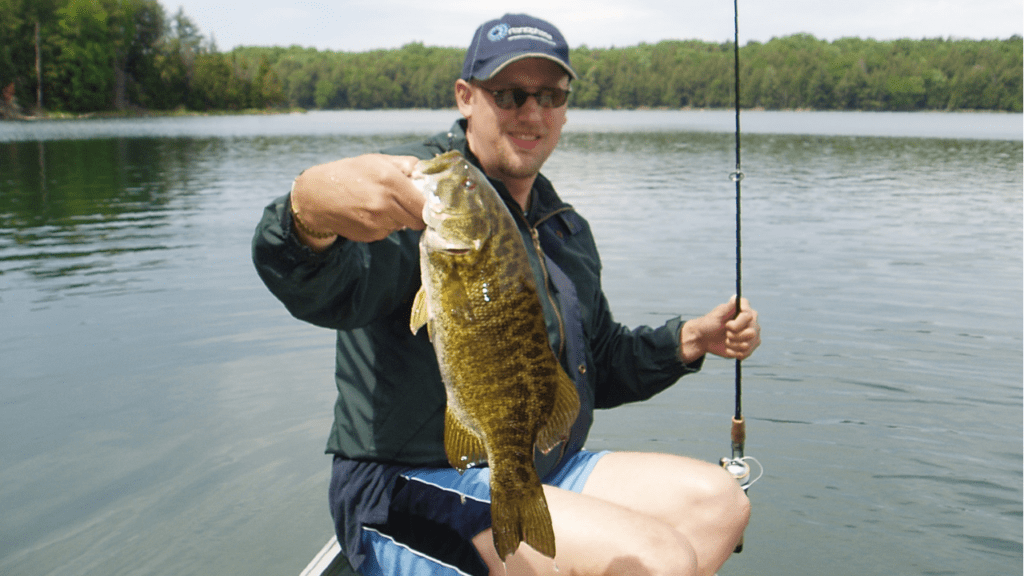Bass fishing enthusiasts constantly seek the edge to transform a good day on the water into a thrilling tale of triumph. Even novice anglers can elevate their game with the optimal blend of skill, equipment, and timing. Knowing the right gear is crucial; a medium-heavy rod with fast action is preferred.
Coupled with versatile lures, such as plastic worms or spinnerbaits, these tools can make all the difference. Mastering the habits and preferred habitats of Bass, like their tendency to hide near structures, helps pinpoint where to cast your line. Dawn and dusk offer prime fishing times as Bass are more active in lower light conditions. By integrating these tips into your bass fishing routine, you’re setting the stage for a potentially successful and enjoyable experience by the water.
The Lure Of Bass Fishing
Bass fishing stands out as a favorite hobby for many anglers. Size and fight make Bass a prize to reel in. Larger-than-life tales often accompany these catches, adding to the sport’s appeal.
Enthusiasts seek the adrenaline rush that comes with the chase. This fish’s notorious unpredictability challenges even seasoned fishers. It’s about patience and the strategy in choosing the right spot and time.
Bass Species: Knowing Your Target
Understanding bass types is vital for successful fishing. The largemouth Bass prefers warmer, stiller waters with abundant cover. Weedy lakes and reservoirs suit them. They grow bigger and fight harder. Smallmouth bass, on the other hand, favors calmer, more transparent, and faster-moving waters. Streams and rivers with rocky bottoms are their homes. They are more diminutive but very feisty.
Each species has distinct feeding habits. Largemouths often ambush prey, hiding among vegetation. They can eat large baitfish or frogs. Smallmouths typically hunt in packs, preying on insects, crayfish, and smaller fish in open water. Knowing where to find them is critical. Seek largemouth in secluded spots, and look to current breaks for smallmouth. Both species adapt to their environments but act very differently. Recognizing these patterns makes catching them more accessible.
Priming Your Gear
Selecting the perfect fishing rod is crucial. A flexible and lengthy rod might be your best bet. Pair it with a lightweight reel for agility. Aim for a rod with high sensitivity and enough strength to haul in big catches. Ideal rods are usually between 6 to 8 feet.
| Reel Type | Reel Feature |
| Spinning Reel | Best for beginners |
| Baitcasting Reel | Great for accuracy |
| Fly Fishing Reel | Top choice for stream fishing |
Match the reel to the rod weight. Ensure a smooth drag and sturdy build. High-quality reels give you more control over your line.
Bait Selection Secrets
Choosing the right bait is crucial for successful bass fishing. Live bait offers natural scents and movements that attract Bass. Examples like nightcrawlers and minnows are top picks for anglers. On the other hand, artificial lures are versatile and can be of various types. From spinnerbaits to plastic worms, they mimic live prey and trigger strikes.
Weather conditions greatly influence bait choice. Warm months call for topwater and shallow lures. Cold seasons require deeper and slower presentations. Keep these pointers in mind to enhance your bass fishing adventures.
Casting Techniques
Bass fishing enthusiasts often seek to perfect their casting technique. The overhand cast is a fundamental skill. To master it, begin with feet shoulder-width apart. Balance is critical for smooth, controlled motion. Grip the rod firmly, then swing it back over your shoulder. As you advance the rod forward, execute a swift flick with your wrist. This sends the lure flying towards your target. A precise wrist action is crucial for accuracy.
Turning to the pitch and flip, these methods are subtle yet effective. Use them when you’re near fish-hiding structures. They need a soft hand. Tiny wrist movements propel the bait. It’s about the finesse. Picture a smooth pendulum. The bait must quietly enter the water, just like natural prey.
Location, Location, Location
Finding the perfect spot is critical for bass fishing. Study the water’s clarity and depth. Plants and structures often hide Bass. Look for water movement, as it can signal bass activity.
Early morning and late afternoon are the top times for fishing. Bass feed actively during these periods. In sunny conditions, aim for shady areas. During cloudy days, Bass roam more freely. Thus, timing can significantly impact your success.
| Time of Day | Tactic |
| Early Morning | Fish in shallow waters, near plants. |
| Midday (Sunny) | Target shaded spots. |
| Midday (Cloudy) | Explore open waters. |
| Late Afternoon | Return to shallow areas and structures. |
Understanding Bass Behavior
Bass fish behave differently throughout the year. Seasons change how and where we find them. In spring, Bass migrate to shallower waters for spawning. They’re aggressive and will bite more. As summer heats up, Bass prefer more profound, more excellent spots. They still eat, but it’s harder to catch them.
Fall brings Bass back to the shallows. They consume ample food to prepare themselves for the winter season. Winter is harsh for fishing. Bass move slowly and eat less in the cold. Knowing about the weather helps, too. The Bass bites better on cloudy days. After rain, they may go after bait in murky water. Wind can push bait to one side of the lake, and Bass often follow. Use these tips to catch more Bass!
Knot Tying Tips
The quest for the perfect bass fishing knot requires patience and practice. Strong knots ensure your line holds during that critical catch. The popular choices among anglers include the Palomar knot, which is reputed for its strength and simplicity, and the Improved Clinch knot, which provides a good balance of ease and robustness.
To improve speed in tying knots:
- Try knot-tying speed drills.
- Use a timer and repeatedly tie the same knot.
- Start slowly to ensure correctness, then increase speed as you gain confidence.
- Practice with different types of lines and in various conditions, as this skill can be the difference between trophy and story.
| Knot Type | Uses | Strength | Speed Training Tip |
| Palomar Knot | General purpose, reliable for various lures | High | Begin with a large hook and thick line for practice |
| Improved Clinch Knot | Attaching line to hooks, swivels, and lures | Medium to high | Challenge yourself to tie it with eyes closed |
Stealth And Approach
To ensure a successful bass fishing trip, stealth is key. Always creep to avoid scaring the fish away. Ensure that your shadow stays clear of the water.
Position your boat with care. Make it so it won’t cast shadows where you plan to fish. This helps to keep the bass calm.
- Use electric motors or paddles for a softer approach.
- Stay aware of the wind and water currents. They can push your boat and create noise.
- Anchor the boat if you need more control.
Setting The Hook
Timing your strike is crucial in bass fishing. A quick reaction often secures a successful catch. Watch for the telltale tug on your line. This is a clear signal to act. Patience plays a key role, too. Wait for the total weight of the fish before setting the hook.
Choosing the right hook makes a big difference. Wider gap hooks are perfect for larger baits. Use thinner hooks for a more natural presentation. Each hook type has its purpose. Match it with your bait and the bass size you aim to catch.
| Hook Type | Use |
| Worm Hooks | For soft plastic baits |
| Jig Hooks | With jig heads for versatility |
| Treble Hooks | On lures like crankbaits |
Fight And Retrieval Tactics
Maintaining tension is crucial during a boss fight. Maintain an elevated rod tip while applying consistent pressure. Adjust the drag on your reel if the Bass pulls hard. This tactic prevents the line from breaking. By keeping a bend in your rod, the tension stops the Bass from throwing the hook.
For successful landing techniques, guide the Bass to the net headfirst. Keep the fishing rod high enough, which can break the rod or lose the fish. Instead, use your reel to bring the Bass close, then scoop it up swiftly with a net. Remember to wear gloves to protect your hands from sharp fins and teeth.
Catch And Release Best Practices
Handling Bass with care is vital for their survival. Always wet your hands before touching a bass. This protects their slime coat, which keeps them healthy. Use a net with soft mesh to prevent injuries when landing them.
Carry proper tools, like pliers or hook removers, to safely remove hooks. Never hold the Bass by the gills or jaw vertically. Support the fish’s weight horizontally to avoid damaging its internal organs. After unhooking, return it gently to the water.
| Do’s | Don’ts |
| Wet your hands before handling | Touch bass with dry hands |
| Use a soft mesh net | Harm the slime coat |
| Support the fish horizontally | Hold the bass by the jaw vertically |
| Gently return to the water | Throw or drop the bass back |
Be quick but gentle to ensure a healthy release. Let the Bass recover in the water by holding it until it swims away. Doing this helps them regain equilibrium and ensures they swim off strong.
Recording Your Success
Keeping track of all your catches is critical to enhancing your bass fishing skills. A simple notebook works, but a digital log is even better. Details matter, so note the location, weather, bait, and time of day. Photos help, too!
Analyzing your past fishing trips can uncover what works best. Look for trends like the bait that gets the most bites. Sunny days may be lucky, or it’s the spot near the lily pads. Regularly review your logs to keep improving.
Advanced Bass Fishing Strategies
Advanced Bass Fishing Strategies demand focus and versatility. Seasoned anglers know that successful bass fishing often hinges on adapting to conditions. Mix up techniques and keep Bass guessing for better results.
Depth is critical for luring Bass, so variance in fishing depths plays a crucial part. Use topwater lures in the early morning or deep divers during bright daylight. The time of day affects bass behavior significantly. Ideal times often include early mornings or late afternoons.
- Consider the weather: Bass are more active under cloud cover.
- Water clarity: Murky water suits vibrant and noisy lures.
- Know the water: Study lake maps and find underwater structures.
Frequently Asked Questions Of Bass Fishing Tips
What Are Top Lures For Bass Fishing?
Small spinnerbaits, soft plastics, crankbaits, and topwater lures are commonly effective for bass fishing.
How To Choose The Right Bass Fishing Rod?
Select a lightweight, sensitive rod with the power and action suited to your preferred bass fishing techniques.
When Is The Best Time For Bass Fishing?
Bass fishing is typically most productive at dawn and dusk during warmer months, as Bass are more active during these times.
Can Weather Affect Bass Fishing Success?
Yes, bass behavior changes with weather patterns; overcast days and barometric pressure shifts can increase fishing success.
What’s The Role Of Water Temperature In Bass Fishing?
Water temperature influences bass activity; they become more active in warmer temperatures, which can signal optimal fishing conditions.
Conclusion
Embarking on your bass fishing journey can transform a leisurely pastime into a thrilling chase. With the strategies shared, your tackle box will brim with more than lures—it’ll overflow with knowledge. Remember, patience and persistence often reel in the best catch.
Now go ahead, cast your line, and let the adventure begin!

